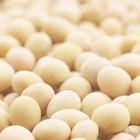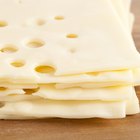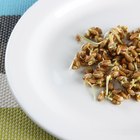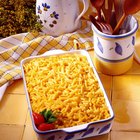
margouillatphotos/iStock/Getty Images
American cheese slices are processed cheeses that are available in a variety of colors--orange, yellow or white. American cheese is a versatile, popular addition to side dishes, sandwiches or hamburgers. Each slice of American cheese supplies vitamins, minerals and calories broken down between fat, carbohydrates and protein. The content of calories and vitamins varies based on the brand and serving size.
Calories
Most American cheese slices come in a serving size from 16 to 28 grams. There are 60 calories in a 16 gram serving and 94 calories in a 28 gram serving. The calories are distributed between fat, carbohydrates and protein. Fat typically provides 45 to 67 percent of the calories, protein provides 12 to 20 percent and carbohydrates provides 3 to 7 percent.
Fat
Fat content in a slice of American cheese varies based on the milk used to make the cheese. Low--fat and skim milk produce cheese that contains a lower amount of fat than whole milk. In a 19 gram serving, there are 4.5 grams of total fat which accounts for 7 percent of the recommended daily value. American cheese is considered high in saturated fat, with 2.5 grams of the total fat coming from saturated fat.
Protein
American cheese slices provide small amounts of protein and are not considered to be a significant source of protein. A 19 gram serving of cheese provides about 3 grams of protein. This accounts for about 12 calories and provides 6 percent of the DV.
Carbohydrates
One of the positives of American cheese slices is the low amount of sugar, with total carbohydrates typically around 1 gram. However, with the absence of carbohydrates, American cheese doesn't provide any dietary fiber.
Vitamins and Minerals
Vitamins and minerals aren't plentiful in slices of American cheese. The few that are present, however, are in significant amounts. About 10 to 20 percent of the DV of calcium--important for bone health--is found in a 16 to 19 gram serving. Vitamin A and sodium provide 4 and 11 percent of the DV, respectively.
Related Articles

How Many Calories in One Piece of ...

The Calories in Garbanzo Beans

Cappuccino Nutrition Information

Calories in Cheese Cubes

Provolone Cheese Nutrition Information

How to Freeze Empanadas

Nutrition in Swiss Vs. American Cheese

Can You Substitute Applesauce for Eggs ...

Calories in Chocolate Covered Pretzels

How Many Calories are in Cheese Lasagna?

Oat Bran Vs. Wheat Germ

Calories in One Slice Provolone Cheese

Does a Sliced American Cheese Product ...

Nutrition Information on Blueberries

Which Country Produces the Most ...

Rolo Nutrition Information

How Much Caffeine Is in Tootsie Rolls?

Feta Cheese Nutrition

Calories in a Cucumber and Avocado Roll

How Many Calories Are in 1 Tablespoon ...
References
Writer Bio
Based in Nebraska, Jeremy Hoefs began writing fitness, nutrition, outdoor and hunting articles in 2006. His articles have been published in "Star City Sports," "Hunting Fitness Magazine" and RutWear field journals, as well as on the Western Whitetail website. Hoefs graduated with a Bachelor of Science in exercise science from Nebraska Wesleyan University.
Photo Credits
margouillatphotos/iStock/Getty Images